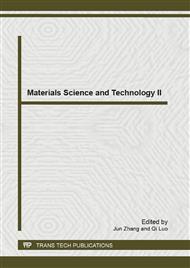[1]
Whitman, W.B., Bowen, T.L. and Boone, D.R.. 2006. The methanogenic bacteria. Prokaryotes 3, 165-207.
DOI: 10.1007/0-387-30743-5_9
Google Scholar
[2]
Ferry, J.G. 1992. Methane from acetate. J. Bacteriol. 174: 489-5495.
Google Scholar
[3]
Mladenovska Z, Hartmann H, Kvist T, Sales-Cruz M, Gani R, Ahring BK (2005) Thermal treatment of the solid fraction of manure: impact on the biogas reactor performance and microbial community. In: Ahring BK, Hartmann H (eds) Proceedings of the 4th international symposium of anaerobic digestion of solid waste August–September 2005. Kopenhagen, Denmark, p.218–225.
DOI: 10.2166/wst.2006.236
Google Scholar
[4]
Padmasiri, S.I., Zhang, J., Fitch, M., Norddahl, B., Morgenroth, E. & Raskin, L. 2007. Methanogenic populationdynamics and performance of an anaerobic membrane bioreactor (AnMBR) treating swine manure under high shear conditions. Water Research 41, 134-144.
DOI: 10.1016/j.watres.2006.09.021
Google Scholar
[5]
Nielsen H.B., Mladenovska Z., Westermann P., Ahring B.K. 2004. Comparison of two-stage thermophilic (68℃/ 55℃) anaerobic digestion with one-stage thermophilic (55℃) digestion of cattle manure. Biotechnol Bioeng 86(3):291–300.
DOI: 10.1002/bit.20037
Google Scholar
[6]
Schink, B. 1997. Energetics of syntrophic cooperation in methanogenic degradation. Microbiology and molecular Biology Reviews 61, 262-280.
DOI: 10.1128/.61.2.262-280.1997
Google Scholar
[7]
Schnurer, A. & Nordberg, A. 2008. Ammonia, a selective agent for methane production by syntrophic acetate oxidation at mesophilic temperature. Water Science and Technology 57, 735-740.
DOI: 10.2166/wst.2008.097
Google Scholar
[8]
Karlsson, A. & Eljertsson, J. 2012. Addition of HCl as a means to improve biogas production from protein-rich food industry waste. Biochemical Engineering Journal 61, 43-48.
DOI: 10.1016/j.bej.2011.12.003
Google Scholar
[9]
Karakashev, D., Batstone, D.J., Trably, E. & Angelidaki, I. 2006. Acetate oxidation is the dominant methanogenic pathway from acetate in the absence of Methanosaetaceae. Applied Environmental Microbiology 72, 5138-5141.
DOI: 10.1128/aem.00489-06
Google Scholar
[10]
Drake, H.L., Kusel, K. & Matthies, C. 2006. Acetate prokaryotes. In: Dworkin, M. et al. The Prokaryotes. 3rd edition. pp.354-420. New York: Springer.
DOI: 10.1007/0-387-30742-7_13
Google Scholar
[11]
Ryan, P., Forbes, C., McHugh, S., O'Reilly, C., Fleming, G.T.A. & Colleran, E. 2010. Enrichment of acetogenic bacteria in high rate anaerobic reactors under mesophilic and thermophilic conditions. Water Research 44, 4261-4269.
DOI: 10.1016/j.watres.2010.05.033
Google Scholar
[12]
Hattori, S. 2008. Syntrophic acetate-oxidation microbes in methanogenic environments. Microbes and Environments 23, 118-127.
DOI: 10.1264/jsme2.23.118
Google Scholar


